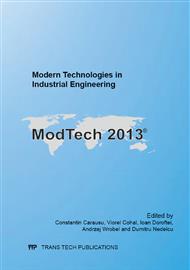p.489
p.495
p.500
p.506
p.511
p.517
p.525
p.531
p.537
Complex 3D Measuring by Multiple Laser Scanning of Automotive Parts
Abstract:
For over 20 years the term "three-dimensional scan" (3D) showed the world the possibilities of virtual design, simulation, or reverse engineering. 3D scanning is also known as 3D digitizing, the name coming from the fact that this is a process that uses a contact or non-contact digitizing probe to capture the objects form and recreate them in a virtual workspace through a very dense network of points (xyz) as a 3D graph representation. Until recently, digitization was limited by the speed of the scan head and the correct choice of the probing system, type of scanned piece and budget for the purchase or develops the scanning system. With the evolution of technology appeared a number of new techniques that tend to improve the properties of classical methods. Even if intended for copying or geometrical control, or rather virtual geometric modelling or product realization, there are two groups of technologies: with contact (classical methods with probes) or without contact (laser, optical or combination). Most automotive manufacturers currently use 3D scan metrology based on optical or laser systems to validate products quality. The pieces are initially measured by 3D scanning then they are compared with the designed model (CAD file) using a specialized software. By this comparison producer can interfere very quickly in the manufacturing process to remove the cause of defects, this technique being called Reverse Engineering (RE). There are many variables that affect accuracy of laser scanning and therefore the quality of information: reflectance of surface, colour object, recesses, openings narrow and sharp edges can be difficult to scan. This accuracy may vary from micron to millimetre and the acquisitions size from a few points to several thousand points per second. The overall accuracy of a 3D acquisition system depends above all on the sensors precision and on the acquisition device (acquisition with contact) or acquisition structure (acquisition without contact). In a perfect world or in an integrated production environment, 3D measuring systems should be able to measure all the necessary parameters in a single step without errors, and to render the results in the same way to the manufacturing networks equipped with computers, in formats useful for machines control and processes management.
Info:
Periodical:
Pages:
511-516
Citation:
Online since:
November 2013
Authors:
Keywords:
Price:
Сopyright:
© 2014 Trans Tech Publications Ltd. All Rights Reserved
Share:
Citation:


